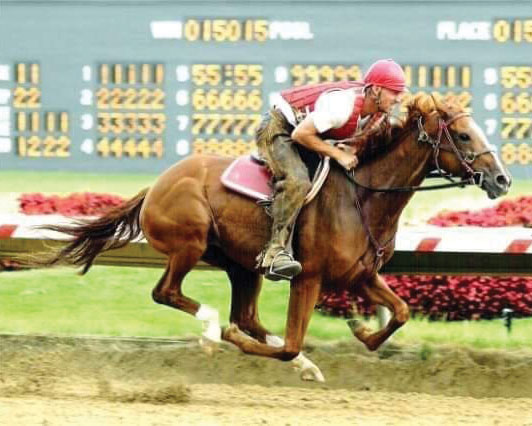Windham Twp. – A trip down Bryant Road may have folks wondering about the horse farm that seemed to have cropped up overnight. To passers-by, it appears that someone likes horses, but its just a bit more than that. Mark and Racheal Maddox, along with their two children bought and began rehabbing the farm in 2016. It is now home to their business, Maddox Racing and Bloodstock.
Mark and Rachael are Oklahoma natives drawn to the area because of the opportunity to race their horses all year round. Mark says, “It was the proximity to several tracks that drew them to northeast Ohio.” Thistledown, Mahoning Valley, Presque Isle and Mountaineer made this location a prime spot for their racing business. In Oklahoma, they only could race seasonal, rather than year-round. They moved to Ohio in 1999 and two years later settled in Nelson Township. In 2016, they bought a 40-acre farm on Bryant Road and moved their business to Windham.
Mark is a lover and nurturer of all creatures. He obtained his primary horse knowledge from being a hunting and fishing guide, where he cared for a string of horses. He acquired his knowledge in the race industry from on-the-job training with seasoned, race horse trainers. Mark started with quarter horses that he broke and trained for racing. Soon a lot of his equestrian students ended up being thoroughbreds. He later moved on and got involved with the Nebraska Racing Circuit. After three years there, they had made enough money to move their family and small string of horses to Ohio.
Fast forward to today, they now own a 40-acre farm and have 35 horses. About half of them are their own, while the others belong to clients. A typical day on the farm can vary, but generally, it involves the basic care of the animals, which can take between 3-8 hours, depending on how many horses they have. Feeding, stall cleaning and checking on them to make sure they are all doing well is a part of the day-to-day operations. Racheal usually handles the day-to-day care of the horses as well as the billing, bookkeeping. employee management and sales. Mark does most of the training and all the work for each horse entered into a race.
They train their horses from birth to the track. Not all horses they breed are track material. Just like people, they have different personalities and conformations. Mark can usually tell by the time they are 2-3 years old if they have the drive, personalities, conformation and speed to be a race horse. If they don’t make it to the track, they are generally sold and used in other forms of the equestrian industry, such as saddle horses, trail horses, 4-H horses, jumpers etc. When a race horse’s career is over, the Maddoxes try to find them good homes that give them a second career. They won’t sell their animals to just anyone. They want them to have good homes with a second life and not be just pasture animals.

Getting a horse ready for the track is not a short process. Training starts at birth, handling them so they learn to trust humans. Then they are taught ground manners and more handling during the first 18 months to two years. The next step is” breaking” the horse They are consistently worked with bits in their mouths, approved saddles and people on their backs. Once they are strong enough and smart enough to handle a rider at a walk, jog, and slow gallop, then they are ready to go to the track to learn the ropes. Sometimes a horse will need time to grow stronger and more mature, getting a 30 – 60 day break to do that before going to the track. An experienced trainer like Mark can tell if a horse needs the break.
Once a horse gets to the track, it can take 6 months to 2-3 years to get them race ready. Injuries, sickness, and cash flow can slow the process down. A horse has to get fit, be tattooed for identification purposes and be approved as safe for the track. A horse has to adjust to noises at the track, activity around them, and be fast enough to be track ready. The animals need to have a certain number of published workouts to earn a gate card in order to compete. A gate card is a starter’s approval that the animal is well mannered, and fast enough out of the gate to compete.
Once a horse is comfortable with the track and is conditioned, it is time to find a jockey that best fits the horse’s style. On race day, Mark is at the track readying the animal. He matches the animal’s personality and race style to a jockey and his ride style for the race. The competition and distance of the race all play a role in the matching of a jockey. The horse then is ridden through what they refer to as breezes. Breezes are speed workouts. These work outs help to see if the rider and the horse are going to mesh. If it is a good match, the horse and rider will be entered in a race. Sometimes, due to availability for morning training, a horse may have more than one jockey ride on different days. Mark will then have to select the best fit for the horse out of the available jockeys for the particular race the horse is entered in.
It takes a lot of work to get a horse to this point. Maddox rides all of his and his client’s horses and gets them all race-ready. He said that although many race horses live at the track, he prefers to keep his at the farm. He trailers them there and brings them home after a race. Once home, he turns them out in the pasture to loosen up the stiffness that settles in after a race. Mark believe they recover faster and better after a race, by giving them turn-out time in the pasture rather than in a stall.
The Maddoxes also breed horses. Over the years, they have studied blood lines and have done a lot of research in Thoroughbred pedigrees. Through their research, they carefully choose the stallions and match them to their mares for the best possible outcome. That being said, no matter how much research one does, there is still no guarantee that every foal they birth will be a great race horse. In fact, some never make it to the track. The criteria for a good race horse can fluctuate but generally it’s speed, conformation, passion, drive, ability to handle track noise and activity and strength of the animal. Those that aren’t race material, are trained for other equestrian careers.
A race horse racing career is usually over by the time they are 6-8 years old. After that, they can be used for other equestrian careers such as trail riding, 4-H horses, jumpers etc. Mark tries to give all his retired race horses a second career by matching them up with buyers that can use them in the best way that matches with the horse’s abilities and personality.
When asked how they got into racing and if it’s their passion. Racheal was the first to respond. She said, “It was a passion when we started, but now it’s what we do.” Mark concurred her statement. However, after watching them interact with their animals, I disagree. I believe the passion is still there, just buried in the hard work and all the responsibilities.
The racing industry is fickle and it is a gamble to make a living at it. As far as the industry goes, the Maddox’s business is not considered a success, however they beg to differ. They credit their faith in God as to why they feel they are successful. They have a roof over their heads, and raised their family on the income generated from their business. They also are able to make enough money at it, to keep the farm running and investing their money back into farm improvements. They have also managed to put their oldest son through college.
Success isn’t gauged by how much money you make, it’s about doing something you love, making a decent living at it and being truly happy. That is why I’d call their business a success.















